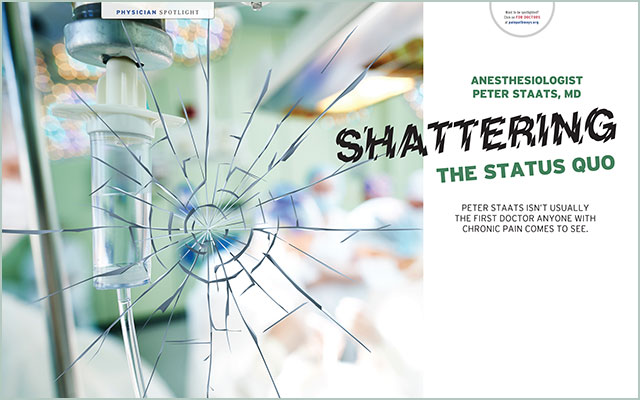Peter Staats, MD

Peter Staats isn’t usually the first doctor anyone with chronic pain comes to see.
“I tend to be the guy who sees people after they’ve been to a few other doctors,” says the anesthesiologist and chief medical officer of both National Spine and Pain Centers and Electrocore Medical. “It’s been that way my whole career. Patients come to me because easier therapies others have tried didn’t work or sometimes because no one has taken the time to figure out the source of their pain.”
What does the New Jersey doctor do that other physicians may not be doing? Dr. Staats begins simply: “I start by attempting to validate my patients’ concerns.
“For people who have pain, there’s almost always a physical reason for it,” he says. “Of course, there may be emotional components that go along with it—which is not to say the pain is just in their heads.
“You’ve got to begin with a diagnosis,” says the former Johns Hopkins medical school professor, who was also chief of Hopkins’ pain medicine division from 1994 until 2003. “And you’ve got to try to be sure it’s the right diagnosis.”
Dr. Staats gives the example of radiculopathy, known in layperson’s terms as a pinched nerve, which results in pain that radiates out from the spine in the pattern of the nerves. “It’s almost always assumed to be a back problem,” he says. “But it can come from an entrapment of nerves somewhere else in the body.”
The correct diagnosis gets a patient to the most effective treatment faster. And, contrary to what a lot of pain doctors say today, surgery may be Dr. Staats’s first recommendation. “I don’t think of surgery as a last resort,” he says. “Once you make a diagnosis, you use an evidence-based approach to determine the best treatment strategy. It could be implanting a spinal cord stimulator. Or it could be surgery.”
Challenging Theories
Dr. Staats has never been afraid to question the establishment. “I started my career challenging concepts of behavioral orientation,” he says. In the early 1990s, people with pain were thought to have personality disorders. Dr. Staats rewrote the playbook. His new theory of pain outlined where interventional therapies and neuromodulation fit in.
“This theory came about at a time when patients with pain were considered to have a behavioral problem,” he says. “It was a time when the primary theory suggested that if you ignored pain behaviors, the pain would go away. I wrote this new theory with two psychologists, one of whom was my father and mentor.” (See sidebar.)
The seminal 1996 paper “Psychologic Behaviorism: A Basis for Unity” attempted to integrate the psychology (cognitive and behavioral approaches) with the biology (neurosurgical, rehabilitative and interventional approaches).
The old school of thought (known as the Skinnerian approach) suggested that if someone in pain didn’t pay attention to the symptoms, the pain would lessen or go away. But if someone in pain dwelled on the pain, it became worse. “To me, this flies in the face of the neurobiology of pain,” Dr. Staats says. “Working with my dad (a leading behavorial psycholgist) and researcher Hamid Hekmat, we defined pain as an emotional response. As such, cognition, personality traits and language can exacerbate or ameliorate pain.”
Dr. Staats Goes Mainstream
The iconoclast wasn’t on the periphery for long; Dr. Staats’s pioneering ideas were soon proven correct. At a time when science didn’t agree, Dr. Staats felt a comprehensive approach to pain was necessary and lobbied the anesthesiology department chair at Johns Hopkins University to classify pain medicine as its own department. He served as an adjunct associate professor there for 13 years and became the first anesthesiologist to be granted surgical privileges at any university training program. He led the way, but he didn’t do it alone. Collaboration, Dr. Staats says, was key to “a fantastic, integrated pain program.”
For all his unconventional thinking, he’s a pragmatist. “Not everyone I work with can be cured,” he admits. “I can try to set people in the right direction, but not everyone wants to hear or take my suggestions. There are some people who want to be on an opioid for the rest of their lives, even when I tell them they could get better without it. I can’t help that person.”
Like the majority of doctors today, he’s concerned about the opioid crisis. He’s even addressed members of New Jersey Governor Chris Christie’s working group on opioids on “how interventional therapies … are the solution to dueling problems of uncontrolled pain and the opiate epidemic. If we just say no to drugs and ignore the pain, people will turn to the streets. We need to treat the pain, minimizing opiate therapy when possible.”
In his own practice, he carefully monitors anyone taking opioids. “I look for any adverse effects and to be sure there are no abusive patterns evident,” Dr. Staats says. “For safety, every patient on opioids needs to be watched closely.”
His ideas—once radical—have since become best practices. One of the two companies for which he serves as CMO, National Spine and Pain Centers, is the largest pain practice in the United States, with offices in North Carolina, Virginia, Maryland, New York, New Jersey and Connecticut. “We are a private practice,” he says, “but we’re attempting to build out the science of our field. Developing algorithms that we can all agree upon, advancing research, mentoring our young doctors, working collaboratively with … seasoned docs and challenging the status quo is really exciting.”
In the Lab
So is the research he’s leading.
Dr. Staats was co-principal investigator in the nation’s largest implanted pain pump trials. The trial, done in conjunction with medical oncologist Tom Smith and Medtronic, demonstrated that pumps worked better than narcotics alone in patients with cancer pain.
Another important trial started small and slow—with a snail. Dr. Staats and team isolated a compound from a snail in the Philippines, put it in the pump and infused the serum into the spinal fluid. The powerful non-narcotic analgesic became Ziconotide or Prialt. “This was the first—and still only—new drug approved by the FDA for implantable pumps, after morphine and baclofen,” Dr. Staats says. The FDA approved its use in pain pumps in 2004.
His company, Electrocore, is “delivering the first real electroceutical for pain control,” Dr. Staats says. The noninvasive therapy—which involves a device the patient places on her neck, along with conducting gel, for just two minutes—has proven successful in treating episodic cluster headaches. The product, released in July 2017, works on the vagus nerve (running from the brain to the abdomen) and is showing early promise in treating traumatic brain injury, Alzheimer’s, Parkinson’s, arthritis and even liver disease. “The company is challenging how we approach health care in a variety of ways and researching patients with multiple unexplained symptoms,” says Dr. Staats.
Science is now catching up to Dr. Staats. “The speed of innovation is increasing,” he says. “Neuromodulation has been a great interest of mine; we have novel wave forms and frequencies that are improving outcomes of spinal cord stimulators.
“This is a fantastic and exciting time in pain management and health care,” he concludes.
PainPathways Magazine
PainPathways is the first, only and ultimate pain magazine. First published in spring 2008, PainPathways is the culmination of the vision of Richard L. Rauck, MD, to provide a shared resource for people living with and caring for others in pain. This quarterly resource not only provides in-depth information on current treatments, therapies and research studies but also connects people who live with pain, both personally and professionally.
View All By PainPathways






